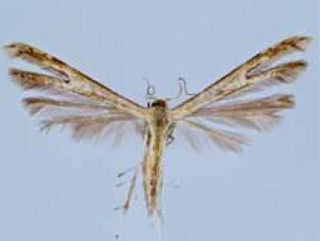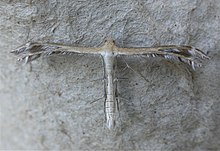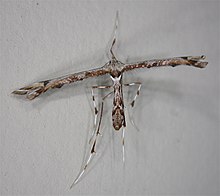
The Pterophoridae or plume moths are a family of Lepidoptera with unusually modified wings, giving them the shape of a narrow winged airplane. Though they belong to the Apoditrysia like the larger moths and the butterflies, unlike these they are tiny and were formerly included among the assemblage called "microlepidoptera".

Crambinae is a large subfamily of the lepidopteran family Crambidae, the crambid snout moths. It currently includes over 1,800 species worldwide. The larvae are root feeders or stem borers, mostly on grasses. A few species are pests of sod grasses, maize, sugar cane, rice, and other Poaceae. The monophyly of this group is supported by the structure of the tympanal organs and the phallus attached medially to the juxta, as well as genetic analyses.

Agdistis is a genus of moths in the family Pterophoridae described by Jacob Hübner in 1825. It is the only genus in the Agdistinae subfamily which was described by J. W. Tutt in 1906.

Ochyrotica is a genus of moths in the family Pterophoridae and only genus in the Ochyroticinae subfamily. Ochyrotica was described by Lord Walsingham in 1891 and the subfamily Ochyroticinae was described by Lutz Thilo Wasserthal in 1970.

Platyptilia is a genus of moths in the family Pterophoridae. The genus was described by Jacob Hübner in 1825.

Stenoptilia is a genus of moths in the family Pterophoridae.

Exelastis is a genus of moths in the family Pterophoridae.

Pselnophorus is a genus of moths in the plume moth family, Pterophoridae. They are native to the Northern Hemisphere and southern Africa. As of 2014 the genus contains eighteen species.

Hellinsia is a genus of moths in the family Pterophoridae. It was created by J.W. Tutt in honour of the entomologist John Hellins.

Marasmarcha is a genus of moths in the family Pterophoridae erected by Edward Meyrick in 1886.

Megalorhipida is a genus of moths in the family Pterophoridae described by Hans Georg Amsel in 1935. Species in this genus are distributed in pantropical and subtropical climates. The species typically nests on host plants in the families Nyctaginaceae, Amaranthaceae, Fabaceae, Goodeniaceae, Asteraceae, and Verbenaceae. The generic name is often misspelled as Megalorrhipida. The species formerly placed in the genus Antarches are now considered to belong to this genus.
Walsinghamiella is a genus of moths in the family Pterophoridae.
Singularia is a genus of moths in the family Pterophoridae. It includes all species formerly placed in the genus Chocophorus and five new species described in 2016.

Merrifieldia is a genus of moths in the family Pterophoridae. It has an Old World distribution, with species known from Asia, Africa and Europe.
Cosmoclostis is a genus of moths in the family Pterophoridae. Species are known from Australia, China, South and South East Asia, the Arabic Peninsula and Africa.

Adaina is a genus of moths in the family Pterophoridae. The genus was erected in 1905 by J. W. Tutt. Several of its species have gall-inducing larvae, such as Adaina primulacea, of which the larvae induce stem galls on Chromolaena odorata, and Adaina microdactyla, which induces stem galls on Eupatorium cannabinum.
Crassuncus is an Afrotropical genus of moths in the family Pterophoridae.

Emmelina is a genus of moths in the family Pterophoridae with a nearly cosmopolitan distribution.
Gypsochares is a genus of moths in the family Pterophoridae.

















